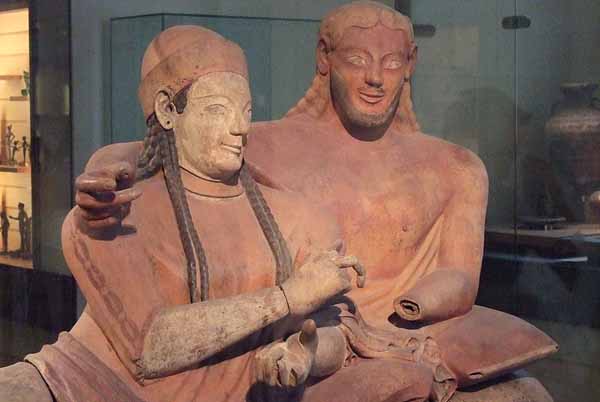The twelve city-states of Etruria evolved into a highly sophisticated and prosperous society that celebrated life through pleasures yet failed to develop political unity.
The twelve independent city-states that comprised Etruria represented the first great ancient culture to emerge in Italy. Etruscan civilization influenced Rome through architecture, religion, and the games. Eventually conquered by Rome in the 4th Century, Etruscan cities would become fully Romanized, leaving only tomb drawings and artifacts to help tell their story.
Etruscan Origins and Early Civilization
Scholars differ as the origins of Etruscan civilization. Oriental motifs in their early art led to speculation that these peoples migrated from either Asia Minor or Phoenicia. There is also evidence linking them to Mesopotamia and the Assyrians. Other historians believe they were an indigenous people, evolving from the agricultural settlements between the Arno and Tiber Rivers.
The civilization flourished during the 7th and 6th Centuries BC and its peoples were known for their zest of living. This included elaborate banquets, even at funerals, featuring prodigious wine consumption, sensual music, and entertainments. Funeral entertainments involved “games” such as boxing and were fought to the death. This may have been the origin of Roman gladiatorial contests.
Greeks familiar with Etruria left a portrait of a highly hedonistic society, at least among the wealthy class. These Greek reports came out of merchant and artisan colonies living in Etruscan cities, like the Corinthians. Scholars point out, however, that other than Greek sources, stories of uninhibited sexuality may be exaggerations.
It is true that the Romans viewed the later civilization as one of immorality, particularly after the “Rape of Lucretia,” resulting in the expulsion of the Tarquinian dynasty from Rome. This would be the beginning of the Republic and the eventual Roman conquest of Etruria.
Divination, Decline and Fall of the Etruscan Civilization in Italy
Etruria’s prosperity was based on its metallurgy. Copper, iron, and tin were traded for gold. The Etruscans also introduced the grape vine to Italy. Trading with the Greeks and Carthaginians, the Etruscans frequently resorted to piracy. Much of this ended after the Etruscans were defeated by the Greeks in a naval trade war that involved the Carthaginians.
Divination also played a large role in religious and social traditions. Etruscan high priests used the livers of sheep to prophesize, even foretelling the eventual destruction of their civilization. It is believed that the soothsayer who warned Julius Caesar about the Ides of March was an Etruscan with powers of divination.
The independence and expansion of Rome denied the use of the Tiber to the Etruscans as it did Etruscan trade and commercial interests in the south of Italy. By the 4th Century, Rome began to conquer the various Etruscan cities, Veii taken in 396BC after a long siege and Tarquinia in 351. Additionally, slave revolts further crippled the old civilization.
Etruscan Tombs and the Afterlife
What is known about the Etruscans comes chiefly from the half-million tombs left by the civilization. Because the afterlife was a continuation of life on earth, elaborate tombs were constructed, carved into the volcanic rock that dominates the region. These tombs, as in most ancient societies, represented the wealthy class.
Built as dual or twin cities, the tomb interiors copied the everyday residences of rich Etruscans. Food and drink was placed inside and the walls were adorned with depictions from life. Intricately carved sarcophagi highlighted wealthy Etruscans and their wives. These tombs have also given up detailed Greek pottery.
As the civilization began to wan, the happy afterlife gave way to changes. The next life was torturous, a place filled with evil spirits. Such changes are evident in other ancient cultures as well, such as the Egyptians of the late New Kingdom.
Etruscan Influence on Rome
The arch and vault as well as “Roman” numerals were products of Etruscan architecture and technical innovation. The first aqueducts built in Rome were Etruscan. Etruscan influences can also be seen in religion and such entertainments as the Circus and gladiatorial competitions. Many of Rome’s diversionary pleasures were inherited from the ancient Etruscans.
Sources:
- Luisa Banti, Etruscan Cities and Their Culture (University of California Press, 1973)
- Mary T. Boatwright, Daniel J. Gargola, and Richard A. Talbert, The Romans from Village to Empire: a History of Ancient Rome from Earliest Times to Constantine Oxford University Press, 2004)
- Michael Grant, History of Rome (Charles Scribner’s Sons, 1978)








